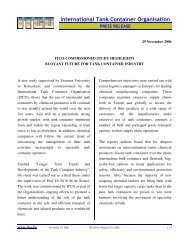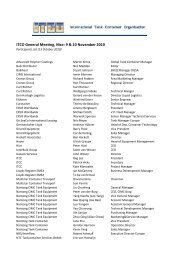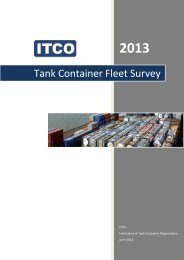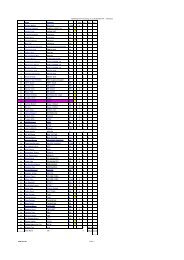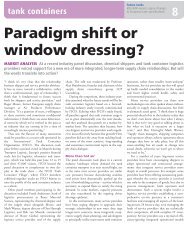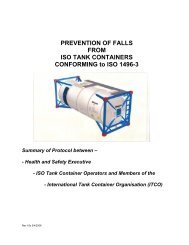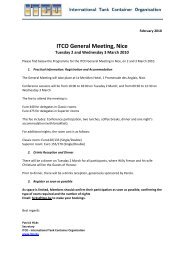You also want an ePaper? Increase the reach of your titles
YUMPU automatically turns print PDFs into web optimized ePapers that Google loves.
ICHCA International <strong>Safe</strong>ty Panel Briefing Pamphlet No 30<br />
5.3.1.6 The number <strong>of</strong> swing bolts or flange bolts varies from type to type and the<br />
pressure rating <strong>of</strong> the tank. However when they are fully tightened they<br />
should form a pressure tight seal that will contain a pressure greater than<br />
the test pressure <strong>of</strong> the tank.<br />
5.3.1.7 Where bolts are used in place <strong>of</strong> studs and nuts to secure the bolted<br />
manway lid care needs to be taken at the time <strong>of</strong> manufacture, maintenance<br />
and periodic testing to ensure that the bolts used are <strong>of</strong> the correct length so<br />
that they may be fully tightened.<br />
Note 1: See Annex 6 for more information on manway lid operation<br />
Note 2: Once the container has been filled, opening the manway hatch / lid<br />
is generally not required until the tank container arrives at its<br />
destination.<br />
Note 3: Many tanks have vacuum relief valves that are not sized to allow<br />
tanks to be discharged without opening the manway or other<br />
fittings. If a tank container needs to be opened, this must be carried<br />
out by a suitably qualified person.<br />
5.3.2 Pressure Relief Valves<br />
5.3.2.1 In general all tank containers whether<br />
they are designed for dangerous or non<br />
regulated goods are fitted with one or<br />
more spring loaded pressure relief<br />
valves which comply with the<br />
recommendations for their design, set<br />
pressures and venting capacity set forth<br />
in the United Nations<br />
Recommendations on the Transport <strong>of</strong><br />
Picture 19<br />
Dangerous Goods - Model Regulations<br />
(Orange Book). The pressure relief valves (see Picture 19) are fitted in the<br />
top space <strong>of</strong> the shell as close to the longitudinal and lateral centre so that<br />
they always remain in contact with the gas or vapour even during the<br />
extremes <strong>of</strong> bad weather.<br />
5.3.2.2 Pressure relief valves can come in two forms:<br />
5.3.2.2.1 Valves may be high pressure only to prevent a build up <strong>of</strong> pressure that<br />
may result in the tank exploding, or,<br />
5.3.2.2.2 Valves may be “twin acting” in that they are designed to relieve both<br />
excess pressure and to provide vacuum-relief in case partial vacuum<br />
conditions arise in the shell. The vacuum relief ensures that the tanks will<br />
not implode due to low pressure.<br />
5.3.2.3 Vacuum relief valves are also fitted on tanks that normally operate at<br />
atmospheric pressure to protect the tank against, for example, the effect <strong>of</strong><br />
low ambient temperature that may cause a reduced internal pressure.<br />
Page 10 ©ICHCA International Limited



